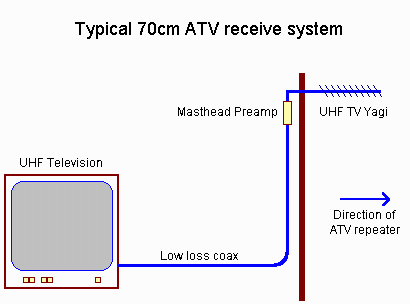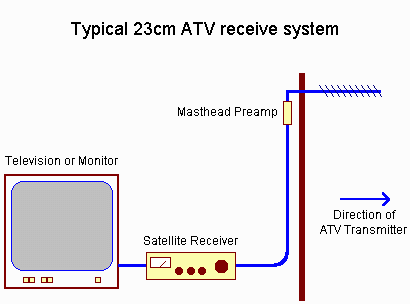|
|
|
|
|
|
|
|
|
|
|
Receiving ATV Pictures
One of the easiest ways to try ATV is by setting up a receive system. The VK3RTV ATV repeater currently has its output on 444.250 MHz which can be received on most normal UHF TV's without any modification. It is a vestigial sideband AM signal which is the same as a normal TV signal. All that is necessary is for the signal to be amplified ( as it is MUCH weaker than a normal broadcast TV signal ). This can be achieved with a small preamp or masthead amplifier and a high gain antenna, or if in direct line of sight you may get a watchable picture with your normal UHF TV antenna. 23cm reception involves a bit more equipment, FM is the mode used on 23cm so an FM receiver must be used and because of larger losses in the coax cable a higher quality cable should be used. 

The output power from the ATV repeater is not very strong (200W ERP) compared to a broadcast station of many thousands of Watts. Fortunately, on UHF, small antennas can have a significant amount of gain. The yagi antenna is the most common in use for ATV in Melbourne. Different types of antennas can be used, either commercial or home brew, with both types in use.
The type of receiver used depends on whether you want to receive AM ( normal type TV ) or FM ( used on satellites ). To receive the 444.250 MHz signal all that is needed is a standard UHF TV.
To receive the 1.2 GHz signal which is FM, a FM receiver needs to be used. The cheapest and easiest way is to use an analogue satellite receiver and then feed the video signal into a monitor or TV. Satellites receivers are not very sensitive so a preamp at the antenna is a must. A suitable preamp can be made or there are lots of used satellite LNB's that can be pulled apart and used very cheaply.
The best location for an ATV receive antenna is where there is a clear and unobstructed view of the transmitter. At UHF frequencies, the signals are attenuated by trees, buildings and hills but there are exceptions to these cases. If you can see Mt Dandenong ( for the repeater ) you probably have an excellent chance of receiving the repeater, if you can't, it might be worthwhile to do a test to see what you can receive ( you never know ). In general the higher ( once the antenna is clear of obstructions between you and the transmitter, extra height will NOT help ) and more "in the clear" the antenna is the better the results will be. People in recent times are putting their TV antenna's inside the roof as they are seen as ugly. Unless you are very close to the transmitter chances are that you will receive nothing. Outside antenna's are the ONLY way to go.
Most preamps and antennas are designed to mount directly to standard TV antenna mast using common U bolts and mast clamps. Note: the ATV repeater output is horizontally polarized ( The antenna elements are level with the ground ).
The coax cable from the antenna to preamp should be kept as short as possible, in the order of 6 feet or less, and should be of the large diameter, low loss variety. The coax cable out of the preamp should be low loss foil shielded RG-59 or RG-6. It is recommended that for these installations RG-6 be used for its better shielding. This will reduce the chances of strong nearby transmitter signals leaking into your ATV receive system. Note that one connector on the power supply (or power inserter) for the preamp feeds DC to the preamp as well as receiving the signal from it. Make sure you do not connect this DC side of the power supply to the television or damage to both may occur. The other connector is a DC blocked IF output for the TV set. Alignment of the antenna is critical, especially for larger antenna's. It can be very difficult doing a trial and error or dual person alignment so take your time. It is very handy for the person actually pointing the antenna to be able to see the point of best reception. The easiest way is to watch for a picture then fine your system or ask on 147.400 MHz for someone to put up a picture for you. Once the best antenna position is found, lock the antenna down tightly. Make sure the coax connections are sealed from the elements. If you need any assistance, our ATV group is always willing to help however we can. Contact us via vk3rtv@hotmail.com or on 147.400 MHz. |
| Contact
! VK3RTV with
comments about this site. - Page last modified: [07-Jan-2009] © Geoff Taurins VK3GE |